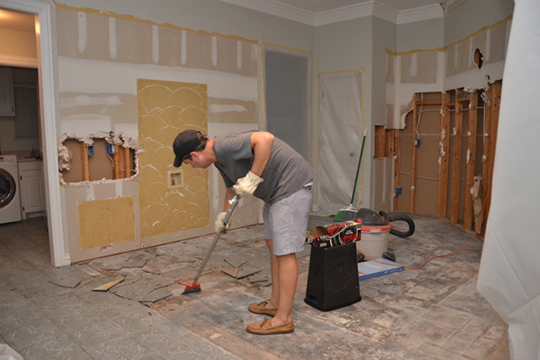One outcome of the Covid 19 Pandemic is that people have spent far more time at home. As a result, home renovation and remodeling is a huge trend. Many choose to do it themselves, but for larger jobs, a contractor is hired. Being A Real Estate Investor and Realtor, I’ve hired many a contractor, and I can tell you from personal experience (as well as the tales of woe from many friends and clients) that hiring a contractor rarely goes according to plan. There always seems to be some kind of conflict; usually minor, but occasionally a full-blown dispute breaks out. Cases like this can get out of hand to the point where the contractor (or subcontractor) files a “Mechanic’s Lien” on your home, which gives the contractor or subcontractor the power to actually foreclose on you and sell your home. This is scary enough for any homeowner, but even worse is the fact that even if you pay the Contractor in charge – “the Direct Contractor”, the one you met and hired – if he doesn’t pay his subcontractors, they can record a lien themselves. Thus, somebody you have never met could foreclose on your home! Or you may be forced to pay the subcontractor(s) as well, meaning you pay twice for the job or risk losing your home! Hopefully I’ve got your attention now, and you read on to learn how to avoid this terrible scenario.
So, what is a “Mechanic’s Lien”? A mechanic’s lien is an encumbrance on the title of real property filed by an unpaid contractor, subcontractor, material supplier, or other laborer (claimant). Because a claimant cannot rescind the work or improvement they have contributed to a property, a recorded lien that attaches to the owner’s title is allowed under the law. In California, mechanic’s lien laws are codified at California Civil Code sections 8000 to 9566.

Here is a list of steps to protect yourself from having a Mechanic’s Lien filed on your property:
Step One: The written contract with the Direct Contractor.
Make Sure Your Written Contract Includes:
- A payment schedule that states when specific phases of the work start and end, and the price for each segment;
- Identification of subcontractors or laborers for each segment**; and
- Identification of material suppliers.
*As mentioned above, your main worry is may not be getting a lien from the direct contractor but from a subcontractor who doesn’t get paid by the direct contractor.
Step Two: Getting Lien Releases
Before making a payment, get a signed conditional release from the possible lien claimants. Lien releases allow property owners to track when potential lien claimants have been paid.
Lien release forms are available from the Conditional and Unconditional Waiver and Release Forms section of the CSLB.CA.gov website. You or your contractor can download a copy of the release. The direct contractor is required to get release signatures for you from the potential lien claimants.
After you pay, the contractor should provide you with an unconditional release signed by each of the claimants paid for the portion of the work being released. Make sure that the actual claimant signs the unconditional release.
Step Three: Payment by Joint Checks
The simplest way to prevent liens and ensure that subcontractors and suppliers are paid is to pay with joint checks. This is when both parties endorse the check.
- Compare the contractor’s materials or labor bill to the schedule of payments in your contract and the Preliminary Notices.
- Make sure that work was done as described.
- Make the check payable to both the contractor and the supplier or subcontractor.
Step Four: File a Notice of Completion and Serve it
By law, you may withhold the next payment until you get the unconditional releases for the previous payment. Under Cal. Civ. Code 8182, an owner can record a notice of completion at any time up to 15 days after the date of completion on a work of improvement. The notice of completion is an important document, as it limits the time a claimant is allotted to file a claim of lien. A direct contractor has 60 days after the filing of a notice of completion to file a claim of lien. If no notice of completion is filed within 15 days of completion of the project, the contractor has 90 days to file a claim of lien.
In California, a notice of completion may relate to the completion of a contract for an improvement as a whole, or a contract for a portion of work. The notice is signed and verified by the owner, who is the person (or persons) with titled interest in the property, regardless of whether or not they occupy it. Within 10 days of recording the notice, the owner must serve copies to the direct contractor and any claimant who has given the owner preliminary notice of a right to lien. Failure to give notice to the direct contractor or a claimant, where required, that a notice of completion has been filed within 10 days of recording it renders it ineffective to shorten the length of time a contractor has to file a claim of lien. The method of serving notice on the requisite parties must comply with Section 8100 of the Civil Code.

Step Five: If a Lien is filed, verify that Contractor followed all the Legal requirements
A claim of lien is executed by the claimant and filed in the recorder’s office of the county where the work site is located. A copy of the claim of lien must be delivered to the owner by mail, and proof of service, signed by the person serving the claim of lien, must accompany the recorded lien document, along with a statutory notice of mechanic’s lien. A direct contractor cannot enforce a lien unless a claim of lien is filed within 90 days after completion of work, or within 60 days after the owner records a notice of completion (Civ. Code 8412). So in California, a mechanic’s lien is only effective for ninety days and will expire thereafter (Civ. Code 8460). Therefore, a claimant must bring an action to foreclosure a lien within ninety days of filing.
Subcontractors and laborers must deliver to the owner and to the construction lender, if any, a preliminary notice of right to lien within 20 days of first furnishing labor, materials, services, or equipment. If a preliminary notice is served later, the claimant’s lien is limited to the labor, materials, services, or equipment furnished within 20 days’ service of the late notice and any labor furnished thereafter. If a claimant fails to provide notice, they lose the right to lien.
The preliminary notice under Cal. Civ. Code 8200 et seq. can be delivered in person or mailed. The law also provides that notice can be recorded “for the limited purpose of facilitating the mailing of notice by the county recorder of recorded notices of completion and notices of cessation” (Civ. Code 8214). According to law, the preliminary notice is maintained under a separate index, apart from constructive notice documents; it does not constitute such notice to any party when recorded.
If the contractor, subcontractor, laborer, or material supplier fails to follow any of the specific time frames, you can petition the court to remove the lien.
So there you have it, if you’re thinking of hiring a contractor to work on your home, please bookmark this article and refer to it for your piece of mind.



Recent Comments